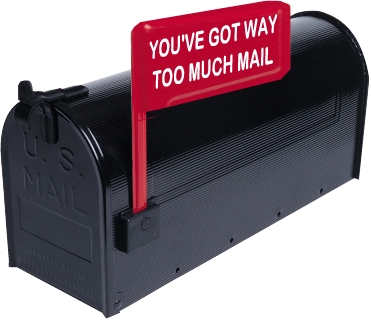on
A new ethics for email

Some ideas are kicking around the Internet about Email. Seth Godin’s email checklist is a great place to start exploring this conversation. Basically, they come down to this: there is too much. People with important jobs and a lot of responsibility get so much email that they can’t even come close to keeping up. It’s not even just forwards and chain mail and list stuff. The truth is, they just know too many people with too many questions and they just get a lot of email from folks they really work with or do business with. There’s too much real, genuine, one-to-one email.
A part of the problem, it seems, is that people treat email too much like talking. If someone says hello to you, you say hello back. If someone does something you asked them to do, you say “thank you.” If someone sends you something they thought you need to know about, you confirm that you got it.
So that’s how we roll with email, too, but it’s getting to be a problem. The idea that seems to be building up out there is this: stop it. Stop the needless replies. If you aren’t adding something or furthering the dialog, maybe you shouldn’t email back. If you do, you’re just one more damn item in the guy’s inbox. Maybe it will only take a second for him to see that all you had to say was “Thanks, check you later,” but opening it, downloading it, seeing it, deciding if he needs to reply, deleting it… that all takes time. And there’s so much of that stuff out there that the time is adding up.
So I’ve kind of quit replying to emails when all I’ve got to say is “Cool, see ya later.” Or “No worries, have a good one.” Or “great job! Thanks!” If you’ve felt like you should have received an email like that from me and didn’t, it’s nothing personal: I’m just trying a new email ethic.
What’s weird is that I often feel rude not sending that final email. Because email often feels like talking (which brings up whole other vast arrays of communication problems people have over email, since it’s not talking), you feel like you should do the things you do when you talk. See above. And people expect those things.
But email is still new. I know it feels like its been with us forever, but I got my first email address in 1995. In the greater scheme of history, that’s not that long ago. We’re still working out how we want to work with this medium. The one thing I think we can all agree on is this: we are all sending out too much email.
Here are some ideas to work with:
- If you aren’t creating dialog, don’t hit send (that is, asking an additional question or offering an additional real thought).
- If a person asks a question to a list of people but, really, only that one person needs to know the answer, use “reply,” not “reply all.” (the classic example, “Let me know if you can make the meeting.”)
- Never email a list with a question without spending a minute to see if you can answer it yourself with a Google search or checking the obvious website or your own old email.
- Come to think of it, don’t email a question to an individual if there’s a pretty good chance you can answer it yourself.
- Even when people have opted in to your email list, use it sparingly. And always generate dialog.
- When replying, don’t use anaphors. Start over with the antecedent. That is, if an employee emails you about the company picnic, don’t reply with “What are you doing about this?” say “What are you doing about babysitting during the company picnic?” You’re not talking and even if he send it 15 minutes ago, odds are that he’s done several things since then.
- When replying to the question someone asked you, be sure it’s not the only question he asked you. I’m looking at you, Blackberry users. 8 ) Email is about keeping dialog going. When it stops, just let it.
- Write. Re-read. Check recipients. Send.
Note from 2020: People keep trying to push sane ideas here and yet 30 years of emailing and people are still replying with “Thank you!” You would think that “NRN” would have caught on at the very least.